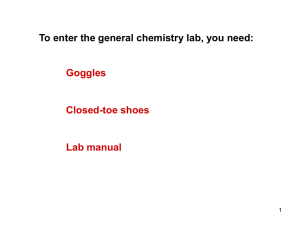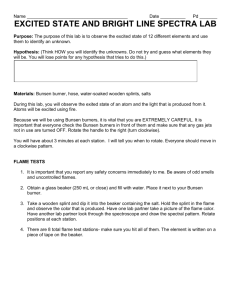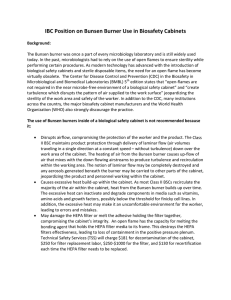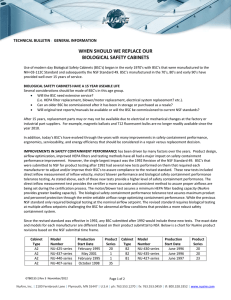TECHNICAL BULLETIN GENERAL INFORMATION
advertisement
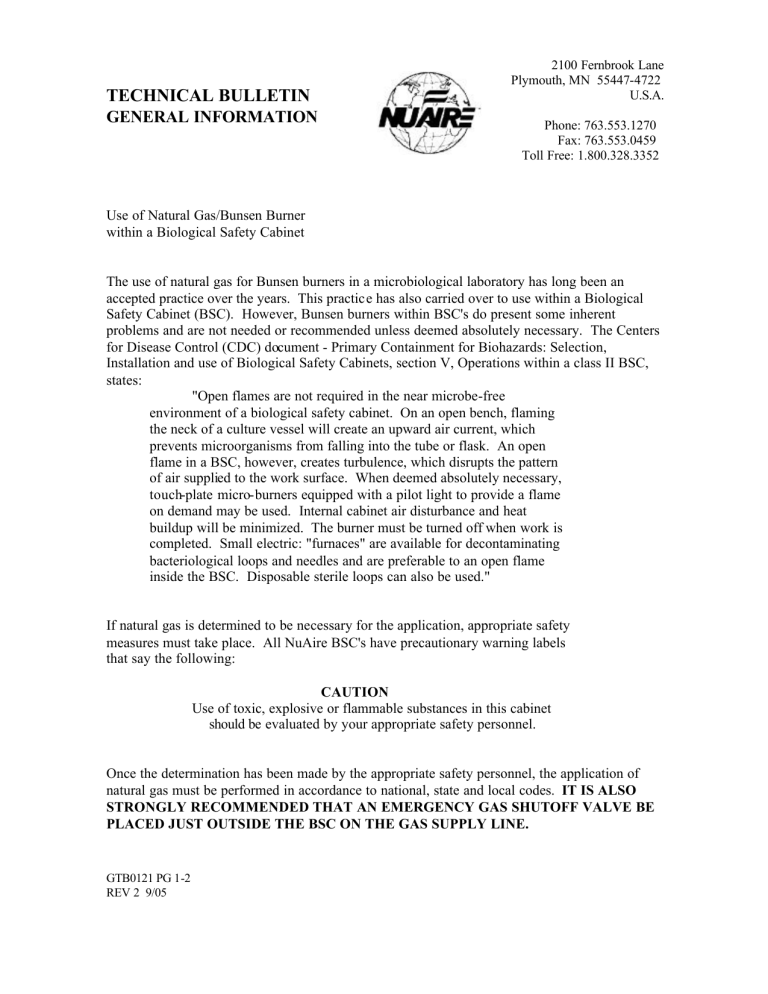
TECHNICAL BULLETIN GENERAL INFORMATION 2100 Fernbrook Lane Plymouth, MN 55447-4722 U.S.A. Phone: 763.553.1270 Fax: 763.553.0459 Toll Free: 1.800.328.3352 Use of Natural Gas/Bunsen Burner within a Biological Safety Cabinet The use of natural gas for Bunsen burners in a microbiological laboratory has long been an accepted practice over the years. This practice has also carried over to use within a Biological Safety Cabinet (BSC). However, Bunsen burners within BSC's do present some inherent problems and are not needed or recommended unless deemed absolutely necessary. The Centers for Disease Control (CDC) document - Primary Containment for Biohazards: Selection, Installation and use of Biological Safety Cabinets, section V, Operations within a class II BSC, states: "Open flames are not required in the near microbe-free environment of a biological safety cabinet. On an open bench, flaming the neck of a culture vessel will create an upward air current, which prevents microorganisms from falling into the tube or flask. An open flame in a BSC, however, creates turbulence, which disrupts the pattern of air supplied to the work surface. When deemed absolutely necessary, touch-plate micro-burners equipped with a pilot light to provide a flame on demand may be used. Internal cabinet air disturbance and heat buildup will be minimized. The burner must be turned off when work is completed. Small electric: "furnaces" are available for decontaminating bacteriological loops and needles and are preferable to an open flame inside the BSC. Disposable sterile loops can also be used." If natural gas is determined to be necessary for the application, appropriate safety measures must take place. All NuAire BSC's have precautionary warning labels that say the following: CAUTION Use of toxic, explosive or flammable substances in this cabinet should be evaluated by your appropriate safety personnel. Once the determination has been made by the appropriate safety personnel, the application of natural gas must be performed in accordance to national, state and local codes. IT IS ALSO STRONGLY RECOMMENDED THAT AN EMERGENCY GAS SHUTOFF VALVE BE PLACED JUST OUTSIDE THE BSC ON THE GAS SUPPLY LINE. GTB0121 PG 1-2 REV 2 9/05 All NuAire BSC's are UL/UL-C listed for safety under the UL and Canadian Standards for Laboratory Equipment (UL3101-1, CSA-C22.2 No. 1010.1-92). NuAire asked UL about the use of natural gas and connections for laboratory equipment relating to the above standard. UL's response was that the above standard does not, at this time, have any specific requirements for natural gas usage or connectors. However, part 2 of the above standard does cover requirements for toxic and flammable gases. The result of their conclusion is "If the product is going to be UL Listed, we would require the connectors to be ASME Certified or equivalent". To comply with the UL requirements, NuAire uses only certified gas valves in our BSC's and has submitted and is listed by UL/UL-C for certified gas valves. If external piping is required, NuAire will use only black pipe for this application. As previously stated, NuAire doesn't recommend the use of natural gas within the BSC and ASSUMES NO RESPONSIBILITY FOR ITS USE. USE AT YOUR OWN RISK. The Bunsen burner flame within the BSC not only contributes to heat build-up; it also disrupts the laminar air stream, which must be maintained for maximum efficiency. IF THE PROCEDURE DEMANDS USE OF A FLAME, A BUNSEN BURNER WITH ON DEMAND IGNITION IS STRONGLY RECOMMENDED. DO NOT USE CONSTANT FLAME GAS BURNERS. During use, the Bunsen burner should be placed to the rear of the workspace where resulting air turbulence will have a minimal effect. Additional References: NFPA 54, National Fuel Gas Code NFPA 45, Standard on Fire Protection for Laboratories using Chemicals NSF Standard 49, Class II (Laminar Flow) Biohazard Cabinetry EN 12469 CDC-NIH, Biosafety in Microbiological and Biomedical Laboratories GTB0121 REV 2 9/05 2



